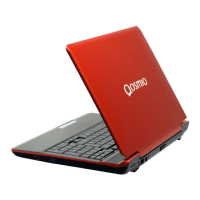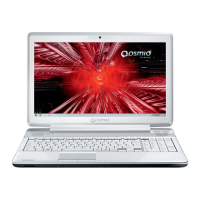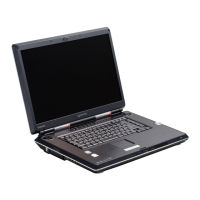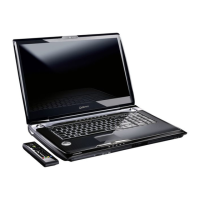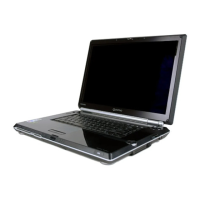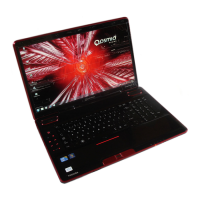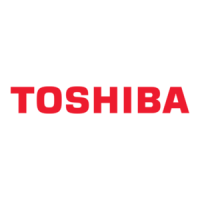
Do you have a question about the Toshiba Qosmio F60 Series and is the answer not in the manual?
| Operating System | Windows 7 Home Premium |
|---|---|
| Storage | 500GB HDD |
| Webcam | Integrated Webcam |
| Audio | Harman/Kardon stereo speakers |
| Connectivity | Wi-Fi 802.11n, Bluetooth |
| Ports | HDMI, VGA, eSATA, Ethernet |
| Battery | 6-cell Lithium-ion battery |
| Processor | Intel Core i3 / i5 / i7 (depending on the specific model) |
Lists all hardware and documentation items included with the computer for setup.
Details the Windows operating system and pre-installed utility software included with the computer.
Describes the computer's front view with the display panel in the closed position.
Details the ports and features located on the computer's left side.
Details the ports and features located on the computer's right side.
Identifies the ports and features on the rear of the computer.
Illustrates the components and ports located on the bottom of the computer.
Shows the computer's front view with the display panel open.
Explains the functions of the system LED indicators.
Describes the CAPS LOCK and NUMLOCK indicator lights.
Details the types of optical disc drives and region codes.
Explains the AC adaptor's function and specifications.
Describes the computer's hardware components like CPU, Memory, and Power.
Details Hard Disk Drives, Solid State Drives, and their capacities.
Explains BD-R/RE and DVD Super Multi drive formats and speeds.
Provides details on the LCD screen resolution and colors.
Details the built-in keyboard and touch pad functionalities.
Lists and describes various computer ports like USB, eSATA, and external monitor.
Covers sound system, web camera, TV tuner, and network interfaces (LAN, Bluetooth).
Highlights unique or advanced features like hot keys and power management.
Details pre-installed TOSHIBA software components and utilities.
Describes pre-installed utilities like Face Recognition and Assist.
Lists optional accessories that expand computer capabilities.
Explains how to use the touch pad and its basic operations.
Details advanced touch pad gestures like ChiralMotion, Pinch Zoom, and Rotating.
Describes AV functions including Media Center, front panel, and remote controller.
Explains how to use the web camera for recording and video chat.
Details how to register and use the face recognition login feature.
Covers loading, removing, and using optical disc drives.
Provides information and limitations for using the TOSHIBA DVD PLAYER software.
Explains limitations and usage of WinDVD BD for Blu-ray disc playback.
Provides tips for protecting CD/DVD/BDs and floppy diskettes.
Details how to use the TV tuner and connect antennas.
Explains how to adjust volume, change system sounds, and use audio managers.
Covers Wireless LAN and Bluetooth setup and usage.
Details how to connect and disconnect to a Local Area Network (LAN).
Provides solutions for common computer problems like overheating and power issues.
Explains the standard alphanumeric keys and their computer usage differences.
Describes function keys (F1-F9) and FN key combinations for special features.
Lists hot key combinations for quick system configuration and feature control.
Details the Windows Start Button and Application keys.
Describes the full-sized keyboard layout with a dedicated numeric keypad.
Explains power states and indicator lights for AC adaptor and battery.
Covers battery types, care, charging, monitoring capacity, and extending life.
Provides instructions on removing and installing the computer's battery pack.
Details setting up User and Supervisor passwords for system access.
Explains Shut Down, Sleep, and Hibernation modes and their configurations.
Guide to launching and using the TOSHIBA HW Setup program.
Covers BIOS version, display settings, and boot priority options.
Details settings for keyboard wake-up, CPU modes, and LAN options.
Explains SATA interface, USB emulation, and front operation panel button settings.
Describes the Media Center functions for watching TV and media.
Details the function of the eco, Wireless On/Off, and Media control panels.
Explains how to assign functions to the operation panels.
Provides information on using the remote controller for computer functions.
Describes video quality modes (Dynamic, Standard, Theater) for QosmioEngine.
Guidelines for identifying and resolving computer problems effectively.
Basic checks and questions to help diagnose malfunctions.
Troubleshooting specific hardware components and peripherals.
Addresses problems related to overheating, AC power, and battery operation.
Troubleshoots issues with Real Time Clock, Password, Keyboard, Display, and HDD.
Solves problems with BD drives, DVD drives, and memory cards.
Troubleshoots Touch Pad, USB mouse, USB devices, and eSATA connectivity.
Addresses problems with memory modules and sound system functionality.
Covers issues with external monitors, LAN, Wireless LAN, Bluetooth, and HDMI.
Provides information on the computer's physical size and dimensions.
Details operating and non-operating conditions for temperature, humidity, and altitude.
Specifies the electrical requirements for the AC adaptor and computer.
Explains how the display controller interprets commands for screen output.
Describes how to configure video mode settings via Display Properties.
Details card form factor, compatibility, network system, and protocol.
Explains how country, product type affect wireless LAN radio characteristics.
Lists 2.4GHz and 5GHz band channel sets for Wireless LAN.
Details Bluetooth standards and logo certification.
Discusses potential interference between Bluetooth and Wireless LAN devices.
Addresses health considerations and regulatory statements for Bluetooth usage.
Details requirements for AC input plug, length, wire size, current, and voltage ratings.
Lists certification agencies for power cords in various countries.
Instructions on how to launch and enable the PC Health Monitor application.
Step-by-step guide to cleaning the computer's cooling module.
Explains icons that may not apply to all computer configurations.
Details factors affecting CPU performance and recommended conditions.
Outlines hardware and software requirements for 64-bit computing.
Explains how main system memory is used by the graphics system.
Discusses factors influencing battery life and capacity degradation.
Defines storage capacity terms like GB, HDD, LCD, GPU, and Wireless LAN.
